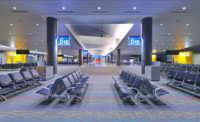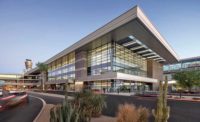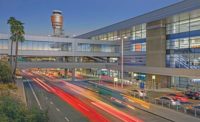Following approval June 11 by Mayor Kate Gallego and Phoenix City Council, the city of Phoenix is sending its airport Comprehensive Asset Management Plan to the Federal Aviation Administration for review.
The long-range vision for Phoenix Sky Harbor International outlines how the nation’s 13th-busiest airport can meet the needs of citizens, business, visitors and new-arrivals for the next 20 years. For the design and construction industry, the value of planned work is estimated at $5.7-billion.
Also known euphemistically as an airport management plan, a Comprehensive Asset Management Plan, or CAMP, is required every seven to 10 years by the FAA to ensure cost-effective decisions are made for future assets such as roadways, aircraft aprons, terminals and other facilities. The last one for the airport was submitted by the city and approved by the FAA in 2010.
Funded by an FAA planning grant, the $3.5-million report includes an inventory of existing conditions and performance, an analysis of development opportunities, project implementation and financing and forecasts commercial airline service as well as air-cargo demand.
“The CAMP is a plan for the future so that we are strategically moving the pieces of the puzzle to meet the needs of our community and those who want to travel and move here,” says Deborah Ostreicher, assistant aviation director for the city of Phoenix Aviation Department.
She explains that the airport, founded on rural land in 1935, is now in the middle of America’s fastest growing major city and was never planned to handle the 45 million annual travelers it does now. Every day, approximately 1,200 aircraft and more than 120,000 passengers arrive at and depart from Sky Harbor, which develops $38-plus billion to the state economy and supports 58,000 jobs, according to city figures.
Split into incremental three- or five-year build plans, the CAMP recommends moving cargo and support operations to the north side of the airport to create room for more gates at terminal facilities and provide space for the Air National Guard 161st Refueling Wing to expand on the south side of the airport. Some of this northside land is owned by the city, and some will need to be acquired, Ostreicher explains.
The CAMP also suggests that the freight railway owned by Union Pacific Railroad be trenched south of Airlane Road for a taxiway bridge so planes can access the relocated cargo operations. And, the report notes that the airport’s roadways should be adjusted to increase traffic flow and security as well as improve access to and from area freeways.
Additional runways are not included in the CAMP because the airport does not expect to have any long-term airfield capacity needs, Ostreicher says.
For the construction industry, the report promises continuing robust activity for two decades at the airport. Currently, the $740-million Phase 2 of the PHX Sky Train is underway, extending the service 2.5 miles from Terminal 3 to the Rental Car Center in early 2022. Four firms are coordinating on the project: Gannett Fleming, designer, and Hensel Phelps, construction contractor, for Fixed Facilities, and, on the system side, Bombardier, design-builder, and The Weitz Company, construction contractor.
At Terminal 3, a $590-million modernization program is underway through a joint design-build venture by HuntAustin. Two components have already been completed with the third, a renovation of the north concourse, in progress. And, an eight-gate concourse is being constructed at the southwest corner of Terminal 4 in a $310-million contract led by McCarthy Building Companies Inc.; this is expected for completion in 2022.
“New projects will be built as demand warrants,” says Ostreicher, noting that no specific time is set for FAA response on the report. “Like all projects the airport embarks upon, each will need to be approved by Phoenix City Council. Then, a competitive process will take place to select contractors and other tradesman to do work on the projects. These projects will create many valuable job opportunities. All projects will be paid for through grants, airport revenues, facility charges and bonds, as no local tax dollars will be utilized.”
The aging Terminal 2 will terminate operations with the completion of the ongoing Terminal 3 Modernization project in 2020. That program is a gate replacement and infrastructure upgrade that will allow the airport to close Terminal 2 and relocate airlines to terminal 3 and 4. A much-needed covered walkway connecting terminals 3 and 4 is also planned in the future as envisioned in the CAMP.
“By making these strategic plans now, we will have more space for the Air National Guard as well as be able to expand and modernize our cargo facilities,” Ostreicher says. “We will need more terminal space, too, which can be very crowded. There are times when there is nowhere to sit, nowhere to plug in. We will need more places to park, for ride share and other services. And, as people travel to Phoenix and Arizona, we will have the capacity to handle their needs in the future.”
For more information on CAMP, visit skyharbor.com/camp.






